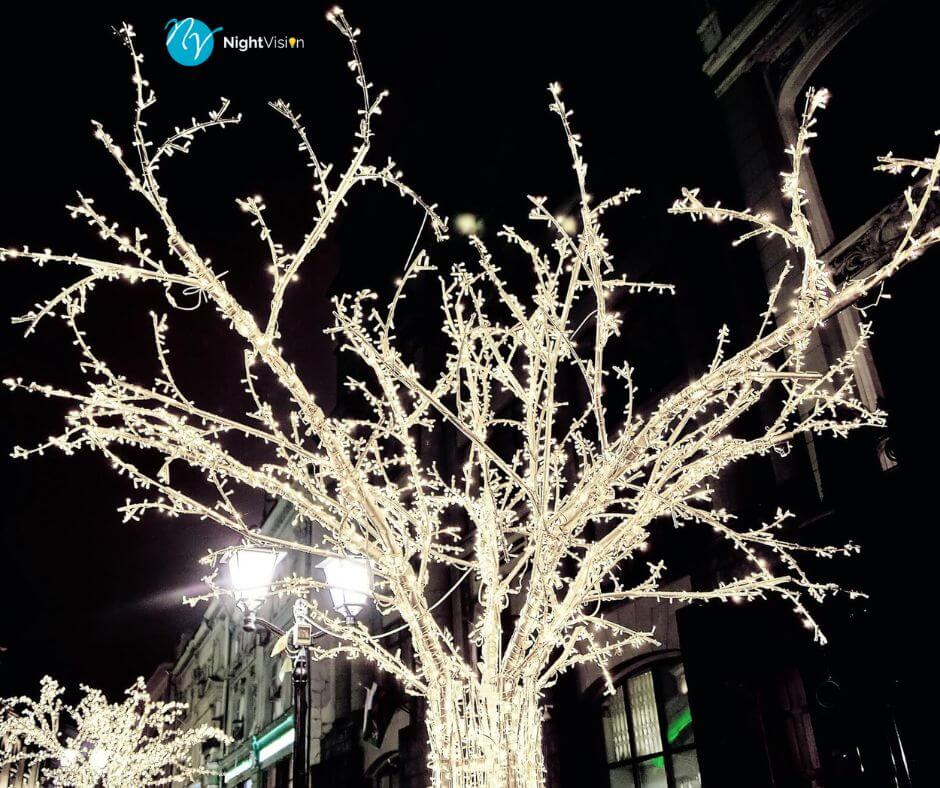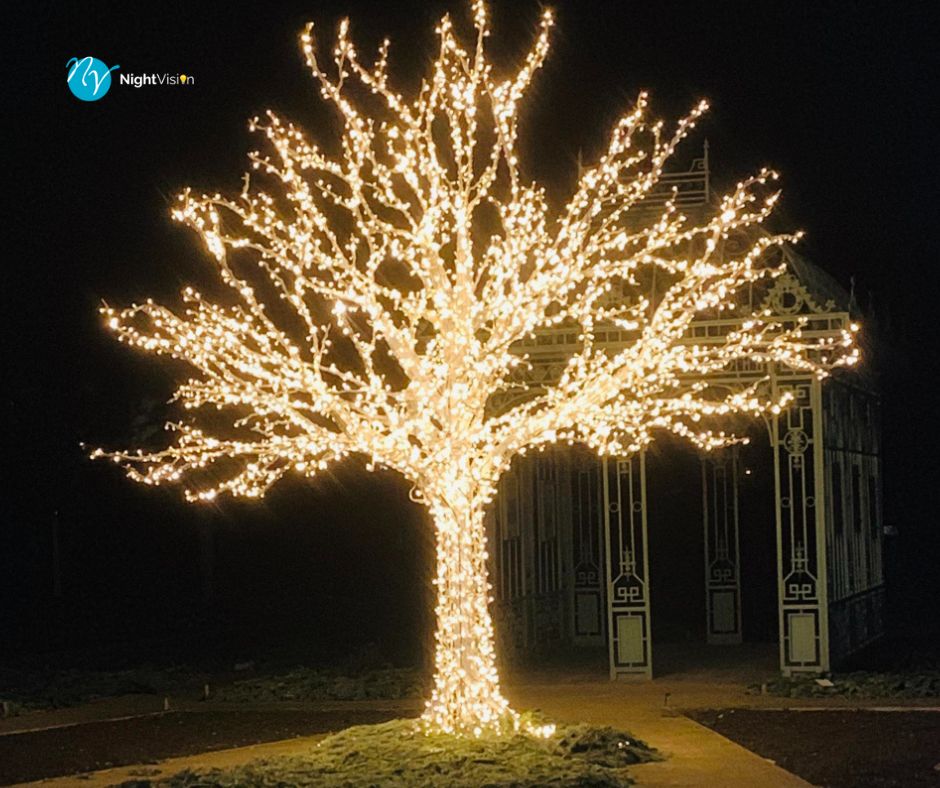Outdoor lighting plays a pivotal role in enhancing the beauty and functionality of any landscape.
Among the myriad ways to illuminate outdoor spaces, the concept of “Tree Glow” stands out as a unique and captivating technique.
In this comprehensive guide, we’ll delve into the art and science of lighting up your landscape canopy, transforming ordinary trees into stunning focal points that mesmerize both day and night.
Introduction
As the sun sets and darkness blankets the landscape, the strategic placement of lights can dramatically alter the ambiance of outdoor spaces.
While traditional landscape lighting often focuses on pathways, architectural elements, and garden beds, the concept of Tree Glow introduces a new dimension to outdoor illumination.
By strategically lighting up trees within the landscape, homeowners and landscape designers can create a magical atmosphere that enhances the beauty and allure of their outdoor environment.
Benefits of Illuminating Trees
Illuminating trees with Tree Glow enhances the visual appeal of your outdoor space and offers numerous practical advantages.
Firstly, it significantly improves safety by providing better visibility in the surrounding area, particularly during nighttime hours.
Well-lit trees help prevent accidents by ensuring pathways and potential obstacles are clearly visible to pedestrians and vehicles alike.
Moreover, illuminating trees can enhance security around your property by deterring potential intruders.
Brightly lit outdoor spaces are less inviting to trespassers, as they are more likely to be noticed by residents or security personnel.
Additionally, the ambiance created by illuminated trees can transform your outdoor environment into a more inviting and enjoyable space for relaxation and social gatherings.
Whether you’re hosting a backyard barbecue or simply unwinding after a long day, the soft glow of illuminated trees adds a magical touch to your outdoor experience.
Overall, incorporating Tree Glow into your landscape design not only enhances aesthetics but also promotes safety, security, and ambiance, making it a valuable investment for any outdoor space.
Types of Tree Lighting
There are various techniques for illuminating trees, each offering a unique aesthetic effect.
Understanding these techniques can help you achieve the desired ambiance in your outdoor space.
Uplighting: This technique involves placing lights at the base of the tree and directing them upward, illuminating the trunk and branches from below.
Uplighting creates dramatic silhouettes and highlights the texture of the tree’s foliage.
Downlighting: In contrast to uplighting, downlighting fixtures are positioned high above the tree and directed downward.
This technique produces a soft, moonlit effect, casting gentle shadows and creating a more subtle ambiance.
Spotlighting: Spotlighting focuses intense beams of light on specific features of the tree, such as exciting branches, foliage patterns, or architectural elements nearby.
It allows for precise highlighting and can create stunning visual focal points.
String Lights: String lights, also known as fairy lights or twinkle lights, are famous for wrapping around tree branches or draping through foliage.
They add a whimsical, enchanting feel to the outdoor space and are perfect for creating a cozy, intimate atmosphere.
Color Changing Lights: These lights allow you to customize the color of the illumination, offering versatility in creating different moods and themes throughout the year or for special occasions.
They can transition between various hues, adding dynamic visual interest to your landscape.
Silhouette Lighting: Silhouette lighting involves backlighting the tree and placing lights behind it to create a striking outline against the night sky.
This technique emphasizes the tree’s shape and form, producing a bold and dramatic effect.
Shadow Lighting: By strategically placing lights to cast intriguing shadows on nearby surfaces, such as walls or pathways, shadow lighting adds depth and dimension to your outdoor space.
It can evoke a sense of mystery and intrigue, especially when combined with foliage.
Understanding these various tree lighting techniques allows you to choose the right approach to achieve your desired ambiance and visual effects in your outdoor environment.
Whether you prefer a subtle, romantic glow or a bold, eye-catching display, there’s a lighting technique to suit every preference and style.
Factors to Consider Before Lighting Trees
Before embarking on a tree-lighting project, several factors must be considered to ensure optimal results and minimize any negative impact on the environment.
Choosing the Right Lighting Fixtures
Selecting the appropriate lighting fixtures is crucial to the success of your Tree Glow project.
Factors such as energy efficiency, durability, and beam angle play a significant role in determining the effectiveness of your lighting scheme.
Installation Techniques
Proper installation is essential to ensure the longevity and effectiveness of your tree lighting system.
Whether you choose to enlist the help of professionals or embark on a DIY installation, understanding the fundamental principles of installation is imperative.
Maintenance and Care
Like any outdoor lighting system, Tree Glow requires regular maintenance to ensure optimal performance and longevity.
By following a routine maintenance schedule, you can prevent issues such as bulb burnout, fixture damage, and wiring malfunctions.
Creative Ideas for Tree Lighting

Beyond basic illumination, there are numerous creative ways to incorporate Tree Glow into your landscape design.
From creating focal points to highlighting architectural features, the possibilities are endless.
Environmental Impact and Sustainability
As stewards of the environment, it’s essential to consider the environmental impact of our lighting choices.
By opting for energy-efficient fixtures and minimizing light pollution, we can enjoy the benefits of Tree Glow while reducing our carbon footprint.
Safety Considerations
Ensuring the safety of both occupants and passersby should be a top priority when designing and installing a tree lighting system.
Adhere to safety regulations and best practices to mitigate potential hazards and enjoy your outdoor space with peace of mind.
Future Trends in Tree Lighting
As technology continues to evolve, so too do the possibilities for tree lighting.
From advancements in LED technology to the integration of smart home systems, the future of Tree Glow holds exciting prospects for homeowners and landscape designers alike.
Conclusion
In conclusion, exploring the diverse techniques of tree lighting can help you create a captivating outdoor ambiance that enhances the beauty and functionality of your space.
Whether you’re aiming for a soft and romantic glow or a bold and dramatic statement, choosing the proper lighting technique is critical.
If you’re interested in incorporating tree lighting into your landscape design, don’t hesitate to reach out to us at NightVision Outdoor Lighting for expert guidance and assistance.
Let us help you transform your outdoor environment into a magical retreat that you’ll enjoy for years to come.
FAQs
What are the benefits of illuminating trees with Tree Glow?
Illuminating trees enhances outdoor spaces’ visual appeal, improves safety by providing better visibility, deters intruders, and creates an inviting ambiance for relaxation and social gatherings.
What are the different types of tree lighting techniques?
Various techniques include uplighting, downlighting, spotlighting, string lights, color-changing lights, silhouette lighting, and shadow lighting, each offering unique aesthetic effects to suit different preferences and styles.
What factors should be considered before lighting trees?
Before starting a tree lighting, consider factors such as choosing the right lighting fixtures, installation techniques, maintenance and care, environmental impact, sustainability, safety considerations, and future trends in tree lighting.
How do I choose the right lighting fixtures for my Tree Glow project?
When selecting lighting fixtures, consider factors like energy efficiency, durability, and beam angle to ensure optimal results and minimize negative environmental impacts.
What are some creative ideas for incorporating Tree Glow into landscape design?
Beyond basic illumination, you can create focal points, highlight architectural features, or experiment with different lighting techniques to add creativity and charm to your outdoor space.
How can I minimize the environmental impact of Tree Glow?
Opt for energy-efficient fixtures and minimize light pollution to reduce your carbon footprint and enjoy the benefits of Tree Glow while being environmentally conscious.
What safety considerations should I keep in mind when installing a tree lighting system?
Adhere to safety regulations, use proper installation techniques, and ensure that fixtures are securely installed to mitigate potential hazards, prioritizing the safety of occupants and passersby.
What are some future trends in tree lighting?
With advancements in LED technology and the integration of smart home systems, the future of Tree Glow holds exciting prospects for homeowners and landscape designers, offering even more innovative and sustainable lighting solutions.
Can Tree Glow be applied to any tree?
Yes, Tree Glow can be applied to a variety of tree species, including deciduous, evergreen, ornamental, and fruit-bearing trees. The key is to strategically place lights to highlight each tree’s unique features and shapes.
Is Tree Glow suitable for both residential and commercial landscapes?
Absolutely! Whether it’s a backyard garden or a corporate campus, Tree Glow can enhance the beauty and ambiance of any outdoor space, making it ideal for both residential and commercial landscapes.
Can Tree Glow be used in combination with other types of outdoor lighting?
Certainly! Tree Glow can complement other types of outdoor lighting, such as pathway lights, garden lights, or architectural lighting, to create a cohesive and harmonious lighting scheme throughout the landscape.



